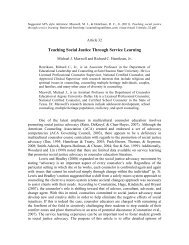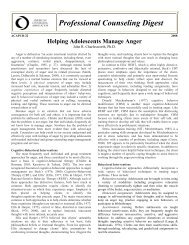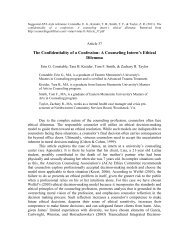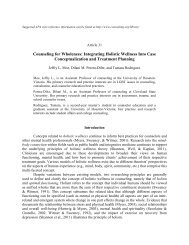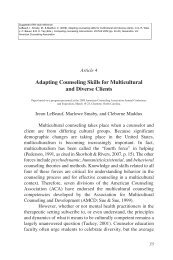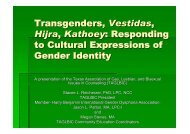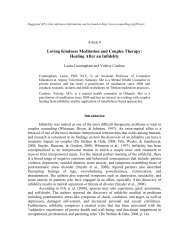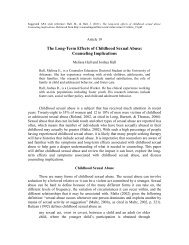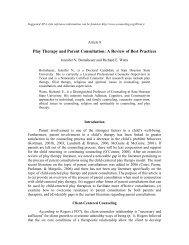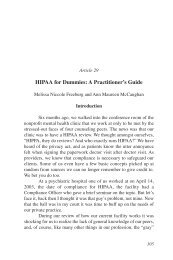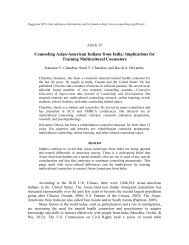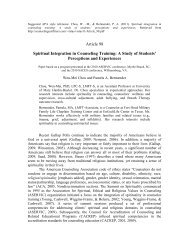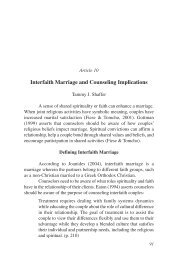Jungian Play Therapy - Counseling Outfitters
Jungian Play Therapy - Counseling Outfitters
Jungian Play Therapy - Counseling Outfitters
You also want an ePaper? Increase the reach of your titles
YUMPU automatically turns print PDFs into web optimized ePapers that Google loves.
Article 15<strong>Jungian</strong> <strong>Play</strong> <strong>Therapy</strong>: Bridging the Theoretical to the PracticalEric J. GreenSexual abuse of young children may produce deeppsychical scars: children may internalize the aberrantfeelings, images, and bodily sensations associated withabuse, which obfuscates and obstructs psychologicaldevelopment (Allan & Bertoi, 1992; Allan & Brown,1993). <strong>Jungian</strong> play therapy promotes psychicalhealing by emphasizing the salience of the positivetherapeutic dyad and encouraging the emergence of theself-healing archetype that is embedded withinchildren’s psyches (Allan, 1988). Once the self-healingarchetype unfolds within the therapeutic container,children will play out themes significant to their innerstruggles (Thompson & Allan, 1987). By reconcilingpolarities that surface within the playroom, <strong>Jungian</strong> playtherapists facilitate children’s inner healing by workingthrough complexes centering on internal struggles,which may include the dichotomies of good and evil,shame and pride, and condemnation and redemption(Kalsched, 1996).<strong>Jungian</strong> <strong>Play</strong> <strong>Therapy</strong> RationaleWith its origins in psychoanalytic theory, <strong>Jungian</strong>play therapy focuses on the psyche’s role in personalitydevelopment. Jung (1963) explained that the evolvingnature of the collective unconscious, with its archetypalmanifestations, influences the process of individuation.Individuation characterizes a progression frompsychic fragmentation toward wholeness—theacknowledgement and reconciliation of opposites(Jung, 1964).<strong>Jungian</strong> theory describes the instinctive yearningsin humans as archetypal remnants that are motivatedby a psychospiritual proclivity for growth and soulfulevolution. Jung (1959) believed humans have a capacityfor conscious self-growth through innate symbols, orarchetypes. Allan (1988) stated the self-healingarchetype is an innate symbol that promotespsychospiritual healing by recognizing and achievinga balanced intrapsychic communication between theego and the self.<strong>Jungian</strong> play therapy is a spiritualized approachto counseling children and emphasizes symbolicmeaning (Jung, 1959). Jung believed that childrencontain a transcendent function—an innate striving forwholeness and personality integration that occurs bysymbolic identification (Jung, 1963). Symbols areproduced unconsciously and appear most commonlyin dreams, artwork, and fantasies. <strong>Jungian</strong>s graspchildren’s symbols only in the context of themacrosystem in which they are contained (Allan, 1988).Allan and Bertoi (1992) stated that one reason<strong>Jungian</strong> therapy is appropriate and efficacious as atreatment modality when counseling elementary schoolchildren affected by sexual abuse is because of thespecialized communication that occurs betweentherapists and clients. Allan (1988) described children’sunderstanding of the world through visual and symbolicmethods. Children express their perceptions of theworld most easily through graphic representations, suchas picture drawings or symbolic play undermetaphorical guises (Allan, 1988; Allan & Bertoi, 1992;Landreth, 2002; Oaklander, 1978). According to Piaget(1962), the symbolic function of play with elementarychildren bridges the gap between concrete experienceand abstract thought most efficiently. <strong>Jungian</strong> therapistsutilize different symbolic interventions, such asspontaneous drawings, to engage children in expressingwishes and repressed or unconscious emotions (Allan,1988).Role of the <strong>Jungian</strong> <strong>Play</strong> TherapistThe therapist’s role is an observer-participant,utilizing nondirective or semidirective techniques thatharness children’s creativity in spontaneous drawingsto bolster their available ego-energies (Allan & Bertoi,1992). <strong>Jungian</strong>s utilize art interpretation and analysisof transference to assess the archetypal or symboliccomplexes within which children are operating (Jung,1959). <strong>Jungian</strong> therapists facilitate children’s discoveryand integration of the dark side of their personality, theshadow, in an effort to maintain psychic equilibriumand promote psychological health (Allan, 1988).75
Landreth, G. L. (2002). <strong>Play</strong> therapy: The art of therelationship (2 nd ed.). New York: Brunner-Routledge.Landreth, G. L., Baggerly, J., & Tyndall-Lind, A. L.(1999). Beyond adapting adult counseling skills foruse with children: The paradigm shift to childcenteredplay therapy. Journal of IndividualPsychology, 55(3), 272-288.Oaklander, V. (1978). Windows to our children. Moab,UT: Real People Press.Piaget, J. (1962). <strong>Play</strong>, dreams, and imitation inchildhood. New York: Routledge.Thompson, F., & Allan, J. (1987). Common symbolsof children in art counseling. Guidance and<strong>Counseling</strong>, 2(5), 24-32.78



